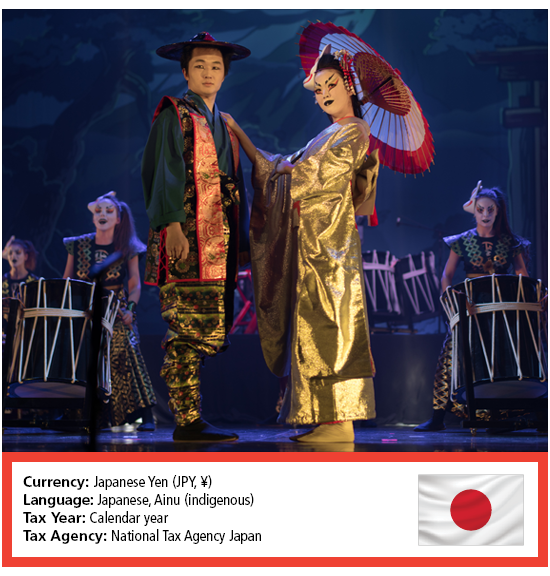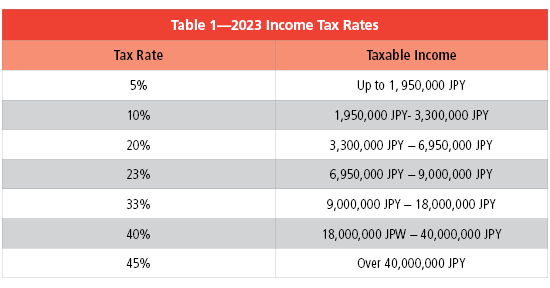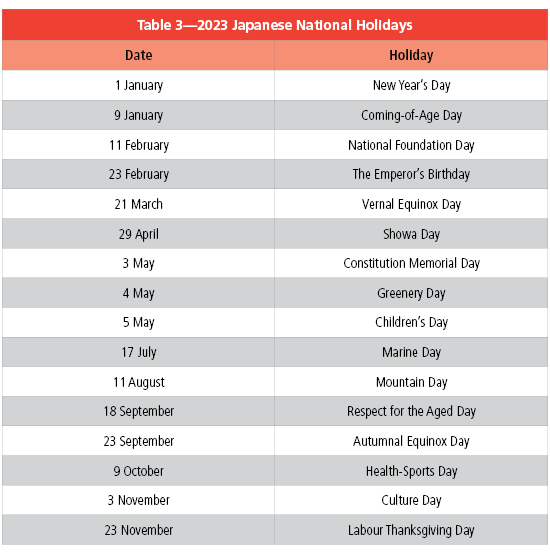 Japan is an island country in East Asia, situated in the northwest Pacific Ocean.
Japan is an island country in East Asia, situated in the northwest Pacific Ocean.
Japan is the 11th most populous country in the world, as well as one of the most densely populated and urbanized. Most of the country's terrain is mountainous, concentrating its population of almost 125 million on narrow coastal plains. Japan is divided into 47 administrative districts and eight traditional regions. The Greater Tokyo Area is the most populous metropolitan area in the world, with more than 37.2 million residents.
The executive power is wielded by the Prime Minister of Japan and his Cabinet.
Japan is a member of the United Nations, G4, G7, APEC, and "ASEAN Plus Three," and is a participant in the East Asia Summit.
Labor Code
The most important piece of employment legislation in Japan is the Labor Standards Act (LSA) of 1947. This is the principal statute that governs the employment relationship and such matters as wages, annual leave, working time, discrimination, maternity rights, and termination of employment.
Other significant labor legislation includes the following:
- The Labor Contract Act
- The Trade Union Act
- The Employment Security Act
The Japan Labor Standards Act requires employers to specify matters related to working conditions, including the period of the labor contract, workplace and content of work, working hours, wages, and matters related to promotion and retirement. Certain aspects, like wage and contract duration, are required to be in writing.
Any company with 10 or more employees is required to maintain a set of work rules and file them with the Labor Standards Inspection Bureau. Include aspects such as work hours, holidays, termination details, and wages in these rules.
Minimum Wage
The current minimum wage is 961 yen (national weighted average; $7.30 USD). It increased from 931 yen for the 2023 fiscal year starting on 1 April 2023.
Working Hours, Conditions
Working hours are set at no more than 40 hours per week, with no more than eight hours of work per day.
Overtime Pay
If an employee works over 40 hours a week, then the company is expected to pay for overtime to the employee unless they work in a management position. Japanese companies that intend to use overtime on a regular basis should put in place a written agreement between employees and management commonly called “article 36″ and submit it to the Labor Standards Inspection Office.
The main types of employee contracts in Japan include the following:
- Permanent or Regular Employee Contracts (Sei-sha-in)
- Fixed-Term or Project-based Employee Contracts (Keiyaku-sha-in): For specific projects or periods. Employees are generally entitled to the same benefits as permanent employees. A fixed-term contract should not exceed three years unless it is tied to completing a specific project.
- Probationary or Trial Periods: The trial period is usually between 90 to 180 days and cannot exceed one year.
- Temporary Staff Contracts or Agreements (Haken-shain): These apply to individuals hired out to companies by agencies and can apply to those having one or two jobs with different companies, or a person employed full-time with a company. In this case contracts are usually for three or six months and can be renewed by the company/agency up to a maximum of three years.
- Youth Employment: The Labor Standards Act bans employment of children under 15 years old unless involved in film, theatre, or artistic performances. Employees under 18 years old may work out of school hours only in light labor roles that do not involve hazardous surroundings or working underground.
- Collective and Trade Union Agreements: Generally, collective agreements are negotiated at the company level and not nationwide or across different sectors or industries.
The Labor Union Act bars employers from refusing to take part in collective negotiations, although the process is not formally regulated.
Foreign Hires
To work full time in Japan, a working visa in needed, which must be sponsored by the future employer in Japan. To obtain a working visa, the foreign employee and the employer must submit various documents to prove eligibility for the job.
Visas
A visa must be applied for before an individual enters Japan. The type of visa required will depend on the purpose of the individual’s entry into Japan. Nationals of certain countries are allowed to enter Japan for up to 90 days without a visa.
Taxes
Unless you have a domicile or have had a residence continuously for one year or more in Japan, then you are considered a nonresident in Japan for tax purposes.
Nonresidents are subject to income tax on their income from domestic sources. They are generally taxed at a flat rate of 20.42%, which is deducted at source. This rate includes 2.1% of the surtax.
To eliminate double taxation on income, taxpayers who pay foreign taxes—which are similar to the Japanese income tax—may choose to have the amount of those foreign taxes credited against their Japanese income tax.
Taxes
The fiscal year 2023 tax reform outline was released on 16 December 2022. In the area of international tax, a global minimum tax, which is conceptually aligned with the OECD Pillar Two initiative, would be implemented for fiscal years beginning on or after 1 April 2024 to ensure a level playing field by reducing international corporate tax competition.
In addition, the proposals include several tax measures to secure stable funds for an increase in defense spending. The details of these measures will be further discussed in 2023 and implemented in stages from fiscal year 2024.
Income Tax
In Japan, permanent resident taxpayers are taxed on their worldwide income. Nonresident taxpayers are taxed only on their Japan-sourced income. Non-permanent resident taxpayers are taxed on their income other than foreign-source income (in particular, potentially, on certain capital gains) that is not remitted into Japan plus potentially part of their foreign-sourced income that is paid in or remitted to Japan.
Japan’s individual income tax system combines a self-assessment system with a withholding system that requires withholding agents (payers of salaries and wages, retirement allowance, interest, dividends and fees) to withhold tax at the time of payment and remit it to the National Tax Agency (NTA).
For tax purposes, individuals living in Japan are classified as:
- Permanent residents—Having either lived in Japan for at least five years or intends to live in Japan permanently. Permanent residents pay taxes on their worldwide income
- Nonpermanent residents—An individual who lived in Japan for less than five years but does not intend to live in Japan permanently. Non-permanent residents pay taxes on all income except income from other countries that are not remitted to Japan.
- Nonresidents—An individual who lived in Japan for less than a year and does not have a primary base of living in Japan. Nonresidents pay taxes on income from sources in Japan but not on income from other countries.
Japan’s personal income tax rates for residents for 2023 is in Table 1.

Social Insurance, Contributions
Japan has four different kinds of insurance systems which companies are legally obliged to take part in; all workers that meet certain criteria are covered by the insurance. These include the following:
- Workers’ Accident Compensation Insurance: This covers any illness or injury at work or while commuting to or from work.
- Employment Insurance: This provides for workers that become unemployed and helps to maintain stable employment such as by providing financial aid and subsidies.
- Health Insurance and Nursing Care Insurance: These cover medical and nursing care expenses incurred by workers.
- Employees’ Pension Insurance: This provides benefits for old age, death, or disability.
Social security law requires contributions to national social and labor insurance systems in respect of employees in Japan (see Table 2). Categories of social security include health, welfare, and labor insurance.
Employer and employee contributions generally align except for labor insurance.
Two programs provide health insurance: national health insurance and employees’ health insurance.

Corporate Tax, Global Minimum Tax
Under the 2023 tax reform, Japan introduces an income inclusion rule (IIR), which is conceptually aligned with the IIR under Pillar Two.
A domestic company that belongs to a specified multinational enterprise group would be liable to pay national corporate income tax on the global minimum tax amount for each target fiscal year. The target fiscal year is a period with respect to which the ultimate parent entity of a specified multinational enterprise group prepares its consolidated financial statements.
The global minimum tax amount is calculated based on various factors outlined in the proposal document and ultimately allocated to national corporate income tax and local corporate tax as follows:
- National corporate income tax is calculated by multiplying the global minimum tax amount by 90.7/100 (“specified base corporate income tax” or SBCIT)
- Local corporate tax is calculated by multiplying the SBCIT amount by 93/907
Should the tax burden rate of a specified foreign-related company’s fiscal year be 27% or higher (currently 30% or higher), the foreign-related company will be exempt from the application of entity-basis income inclusion.
Also, certain documents related to a foreign-related company partially subject to Controlled Foreign Corporation (CFC) rules which were required to be included with tax return filings will now be excluded, and only the requirement to preserve such documents will remain. These revisions will go into effect for fiscal years starting on or after 1 April 2024 to coincide with the implementation of Pillar 2.
Time Off
There are 16 public holidays in Japan. See Table 3 for the full list of holidays in 2023.

Paid Leave
Permanent and contract employees are entitled to a minimum of 10 days paid leave per annum after six months increasing to 20 days with more than 6.5 years of service.
Sick Leave
In general, there are no sick leave rights in Japan. When employees get sick, they use their paid vacation to take a leave of absence.
Maternity Leave
Guaranteed maternity leave in Japan covers a period of six weeks prior to the expected birth date to eight weeks after giving birth. The employee’s salary will be covered by the social insurance up to a limit of around 2/3 of the base salary.
Childcare Leave
Childcare leave applies to both female and male employees. Childcare leave starts from the day after the maternity leave ends (i.e., eight weeks after the birth date), to the day before the child reaches the age of one.
If the employee’s spouse is also on childcare leave, the childcare leave may be extended up to when the child reaches the age of one year and two months old. The duration each parent may take childcare leave should not, however, exceed one year. During childcare leave, payment will be covered by the labor insurance.
Additional Paid Leave
An employee may be entitled to the following additional paid leave due to a death in the family:
- Death of a father, mother, spouse, or child: Up to five days
- Death of a grandparent, grandchild, sibling, child’s spouse, or spouse’s parent: Up to three days
Culture
Japan has a fascinating and multifaceted culture that is steeped in the deepest of traditions dating back thousands of years. But it is also a society in a continual state of rapid flux, with continually shifting fads and fashions and technological development that constantly pushes back the boundaries of the possible.
When doing business in Japan respect for age and hierarchy is very important and bowing to seniors is seen as a sign of respect.